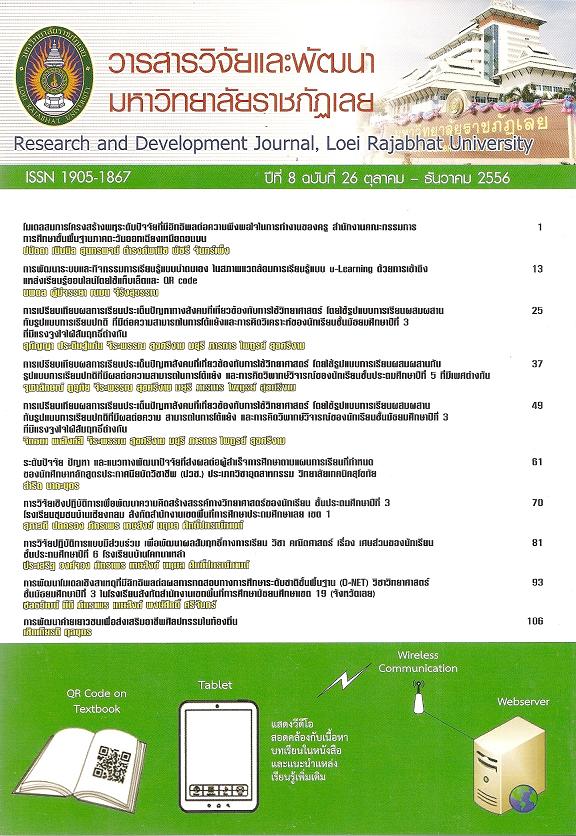โมเดลสมการโครงสร้างพหุระดับปัจจัยที่มีอิทธิพลต่อความพึงพอใจในการทำงานของครู สำนักงานคณะกรรมการการศึกษาขั้นพื้นฐานภาคตะวันออกเฉียงเหนือตอนบน
Keywords:
ความพึงพอใจในการทำงาน, โมเดลสมการโครงสร้าง, การวิเคราะห์พหุระดับ, job satisfaction, structural equation model, multi – level analysisAbstract
บทคัดย่อ
การวิจัยครั้งนี้มีความมุ่งหมายเพื่อวิเคราะห์องค์ประกอบเชิงยืนยันพหุระดับและตรวจสอบความตรงของโมเดลสมการโครงสร้างพหุระดับปัจจัยที่มีอิทธิพลต่อความพึงพอใจในการทำงานของครู สังกัดสำนักงานคณะกรรมการการศึกษาขั้นพื้นฐาน ภาคตะวันออกเฉียงเหนือตอนบน กลุ่มตัวอย่าง คือ ข้าราชการครู จำนวน 1,620 คน ได้มาโดยการสุ่มแบบหลายขั้นตอน (Multi stage random sampling) เครื่องมือที่ใช้ในการวิจัยประกอบด้วย แบบวัดปัจจัยที่มีอิทธิพลต่อความพึงพอใจ ซึ่งประกอบด้วยปัจจัย ความพึงพอใจในการทำงาน, แรงจูงใจใฝ่สัมฤทธิ์, ความฉลาดทางอารมณ์, ความผูกพันต่อองค์การ, การจัดการความรู้, ภาวะผู้นำ และวัฒนธรรมองค์การเชิงสร้างสรรค์ การวิเคราะห์ข้อมูลใช้สถิติเชิงพรรณนา การวิเคราะห์สัมประสิทธิ์สหสัมพันธ์พหุคูณ (r) การวิเคราะห์องค์ประกอบเชิงยืนยัน (CFA) การวิเคราะห์องค์ประกอบเชิงยืนยันพหุระดับ(MCFA) การวิเคราะห์โมเดลสมการโครงสร้าง(SEM) และการวิเคราะห์โมเดลสมการโครงสร้างพหุระดับ (MSEM) ผลการวิจัยพบว่า 1) ผลการวิเคราะห์องค์ประกอบเชิงยืนยันพหุระดับของโมเดลการวัดความพึงพอใจในการทำงาน พบว่ามีความตรงเชิงโครงสร้างหรือมีความสอดคล้องกับข้อมูลเชิงประจักษ์ พิจารณาได้จากค่าสถิติที่ใช้ตรวจสอบความตรงของโมเดล ได้แก่ χ2 = 61.573, df = 50, χ2/df = 1.231, p-value = 0.126, CFI = 0.999, TLI = 0.998, RMSEA=0.012, SRMRB = 0.014, SRMRW = 0.031 2) ผลการพัฒนาและตรวจสอบความตรงของโมเดลสมการโครงสร้างพหุระดับปัจจัยที่มีอิทธิพลต่อความพึงพอใจในการทำงานของครู สังกัดสำนักงานคณะกรรมการการศึกษาขั้นพื้นฐาน ภาคตะวันออกเฉียงเหนือตอนบน พบว่าโมเดลมีความสอดคล้องกับข้อมูลเชิงประจักษ์ โดยค่าสถิติที่ใช้ตรวจสอบความตรงของโมเดลดังนี้ คือ มีค่า χ2= 1529.814, df = 829, p-value = 0.000, CFI = 0.979, TLI = 0.978, RMSEA = 0.023, SRMRW = 0.025, SRMRB = 0.450 และχ2/df = 1.845 ตัวแประระดับครูและระดับโรงเรียนร่วมกันอธิบายความแปรปรวนความพึงพอใจในการทำงานของครูในระดับบุคคลและระดับโรงเรียนได้ร้อยละ 66.80 และ 90.00 ตามลำดับ
Abstract
The purposes of this study were to analyze multi-level confirmatory factor, causal factor influencing teacher’s job satisfaction and develop and test validity of the multi-level structural equation model of factors influencing teacher’s job satisfaction under the office of basic education in the upper north east. The research samples were 1,620 teacher. The research samples were obtained from Multi -Stage random samplings. The research instrument consisted of a Questionair of teacher’s job satisfaction, Achievement Motivation, Emotionaly Quotient, Organization Commitment, Knowledge Management, Leadership, Constructive and Creative Culture. The collected data were analyzed using descriptive statistics, multiple correlation for coefficient analysis, confirmatory factor analysis, multi-level confirmatory factor analysis, structural equation model analysis, and multi-level structural equation model analysis. The study findings could be summarized as follows : 1) The result of analyzing confirmatory factors of teacher’s job satisfaction reviewed that there was construct validly or congruence with the empirical data. This could be considered from statistical values used for checking and the model validity including : χ2= 61.573, df = 50, χ2/ df = 1.231, p-value = 0.126, CFI = 0.999, TLI = 0.998, RMSEA = 0.012, SRMRB = 0.014, SRMRW = 0.031. 2) For the results of developing and checking validity of the model of multi-level factor structural equation and influences of teacher’s job satisfaction under the office of basic education in the upper north east, it was found that the model was in congruence with empirical data. This could be considered from statistical values used for checking and the model validity including : χ2= 1529.814 df = 829, p-value = 0.000, CFI = 0.979, TLI = 0.978, RMSEA = 0.023, SRMRW = 0.025, SRMRB = 0.450 and χ2/df = 1.845. All of the predictive variables at the teacher level and school level could cooperatively predict teacher’s job satisfaction of the teacher at 66.80 and 90.00 percent respectively.
Downloads
How to Cite
Issue
Section
License
ข้อความที่ปรากฎในวารสารฉบับนี้เป็นความคิดเห็นของผู้เขียนแต่ละท่าน สถาบันวิจัยและพัฒนา มหาวิทยาลัยราชภัฏเลย และกองบรรณาธิการ ไม่จำเป็นต้องเห็นด้วยและไม่มีส่วนรับผิดชอบใดๆ
สถาบันวิจัยและพัฒนา มหาวิทยาลัยราชภัฏเลย ขอให้ผู้อ่านอ้างอิงในกรณีที่ท่านคัดลอกเนื้อหาบทความในวารสารฉบับนี้






